One of the big remaining mysteries in animation history is what became of Dave Fleischer after he left the Fleischer Studio. The man spent spent 20 years directing (or getting credit for directing) Koko the Clown, Betty Boop, Popeye, Superman, Gulliver’s Travels (1939) and Mr. Bug Goes To Town (1941) (not to mention Screen Songs, Color Classics and Gabby… but let’s not go there). Some of the greatest (and funniest) cartoons of the 1930s, you’d think the man could write his own ticket.
Instead, it seems he decided to take it easy and let it slide.
Ousted from his Miami studio, he got an offer from the ailing Columbia Pictures’ Screen Gems Studio (in Hollywood) to take over from Frank Tashlin who was going back to the Schlesinger studio. There isn’t much of a Fleischer influence in evidence during his 18 month stint (from Spring 1942 through Fall 1943), save for the idea of animating popular comic strip strong man (in this case, L’il Abner) and remaking his previous Raggedy Ann two-reeler (1940) into a seven-minute Academy Award nominee (the incomprehensible 1943 cartoon Imagination).
Perhaps the reason so little is known about Dave’s post-Fleischer Studios career is because he never really did anything of note after that. 1943’s Polly Wants A Doctor (embed above) is typical of Fleischer’s Screen Gems fare during this time.
In 1944, Dave independently produced animation segments for two live action B-films released by Republic Pictures. First, he appears in Trocadero as himself in several sequences set in the famed nightclub. Apparently Gulliver’s Travels did well enough to afford the him the celebrity to do so, though he seems to be playing a version of “Uncle Max”. In the clip below, he appears with double-talking comedian Cliff Nazzarro:
Dave Fleischer achieved an Associate Producer credit for That’s My Baby (view the entire movie at this link), a curious film about a comic book artist/editor/animator (played by Richard Arlen). In the first scene Arlen is supervising an all-girl cartooning crew (well, it was during the war), towards the end is a great animation production montage (at 1:01:37) and a cartoon sequence concludes the picture (starts at 1:05:15), which looks like a leftover bit from Screen Gems.
Sometime after the war, Dave began a 20-year + relationship with Universal Pictures. According to Leslie Cabarga’s book (and oft-repeated on the internet and other sources):
“Dave went to Universal Pictures where he helped the company out of bankruptcy (he claimed)… using his legendary story chart, he corrected the timing on the film “Francis” starring Donald O’Connor and a talking mule. The picture was a huge success… Dave charted other films for Universal and contributed bits and pieces, ideas and special effects to a number of films including The Birds and Throughly Modern Millie.”
The reality was Dave became the point man for Universal on various special projects. For them he supervised a series of alternate-universe sing-along shorts in the 1950s, produced trailers and handled anything requiring special optical work – particularly animation.
Below is a 1953 invoice for cartoon work required on a trailer (scanned from the Sid Glenar collection at the Asifa-Hollywood Archives). This leads me to believe that Fleischer may have been responsible for the animated opening titles for Abbott and Costello Meet Frankenstein (1948), a sequence usually attributed to Walter Lantz (who was not affiliated with Universal at the time).
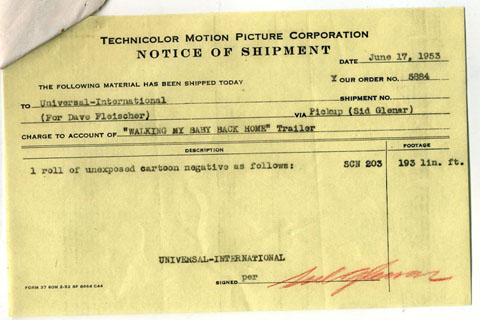
This work at Universal kept Dave Fleischer busy for years. However, it’s recently come to light that Dave may have moonlighted on the famed Technicolor Refreshment Trailer No. 1 (aka, the National Film Registry title, Let’s All Go to the Lobby), an intermission snipe for the Filmack Trailer Company (headquartered in Chicago – and still in business):
What year this was produced in is still a mystery. Filmack themselves do not know. The National Film Registry pegs it at 1957 – but it looks more like something from the late 40s. Here’s a 1953 Filmack advertisement (from Filmack’s trade magazine Inspiration) which promotes that Dave Fleischer was indeed involved in the production of this trailer – as well as another. (Click to enlarge)
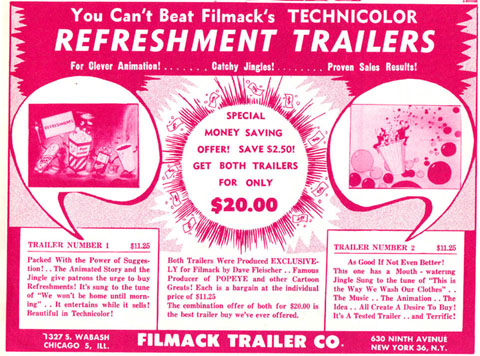
The green image below is the full-page inside cover of Inspiration’s August, 1951 issue, one of Filmack’s first ads promoting their concessions snipes.

Apparently Dave was working both sides of the “sing-along” angle: producing Universal’s Sing And Be Happy series at the same time making “bouncing ball” shorts for Filmack:

All this time, and for years to come, Dave remained happily and anonymously employed by Universal. Anonymously – unless Universal needed him to step forward for some publicity purpose. Dave’s last screen credit was on the English dub of Russia’s The Snow Queen, which Universal picked up in 1959.
These scans (below) from the film’s press book list Dave (under “The Staff”) as Technical Supervisor, and he’s referenced in the publicity article at right. With the old Popeye shorts back on TV, garnering huge ratings in 1959, Dave Fleischer’s name couldn’t hurt in publicizing this animated feature.


Dave Fleischer, age 65 in 1959, at Universal
Dave was also involved with other various outside projects during the 1960s. Robert Coar found this item in the August 1963 of the Cartoonists Union newsletter Top Cel:
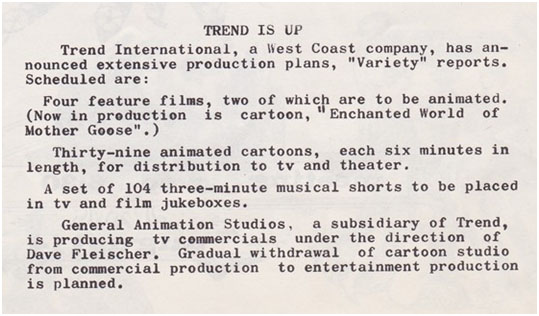
Dave’s freelance arrangement with Universal came to an end in 1967 and spent some of his final years at the Motion Picture Home in Woodland Hills, California. He passed away in 1979 at age 84 and is buried at Mount Sinai Memorial Park in Los Angeles.
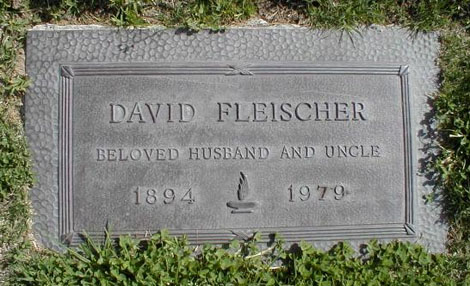
For MORE about what Dave Fleischer did post-1945 – read Don Yowp’s 2020 post on his Tralfaz Blog
(Thanks, Mark Newgarden, John Owens and Walter Forsberg)


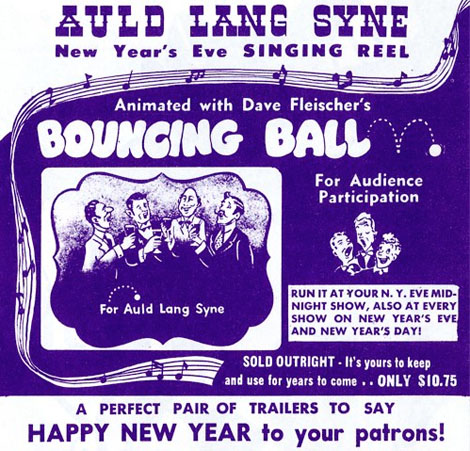
 Jerry Beck is a writer, animation producer, college professor and author of more than 15 books on animation history. He is a former studio exec with Nickelodeon Movies and Disney, and has written for The Hollywood Reporter and Variety. He has curated cartoons for DVD and Blu-ray compilations and has lent his expertise to dozens of bonus documentaries and audio commentaries on such. Beck is currently on the faculty of CalArts in Valencia, UCLA in Westwood and Woodbury University in Burbank – teaching animation history. More about Jerry Beck [
Jerry Beck is a writer, animation producer, college professor and author of more than 15 books on animation history. He is a former studio exec with Nickelodeon Movies and Disney, and has written for The Hollywood Reporter and Variety. He has curated cartoons for DVD and Blu-ray compilations and has lent his expertise to dozens of bonus documentaries and audio commentaries on such. Beck is currently on the faculty of CalArts in Valencia, UCLA in Westwood and Woodbury University in Burbank – teaching animation history. More about Jerry Beck [



































Fascinating how his name was floated out as needed.
Thanks Jerry! Here’s to a new path!
Amazing! You can now be sure that I’ll follow your blog! : )
I wrote him a letter that he got on the day he died. His family called me to thank me for the nice things I said. Later I got a letter from his wife Mae.
Very interesting. Thanks Jerry!
Cool feature Jerry ! I look forward to the new blog site !
I’d probably never be able to prove it, but I swear I remember Dave’s death being announced on a prime-time CBS Newsbreak. At the time I had just discovered the Fleischer cartoons [on a new UHF station] and recognized Dave’s name immediately when it was announced. Looking back now I almost can’t believe it actually happened, given his years of obscurity at that point.
I wonder if he had anything to do with Mammy Yokum “tooting” her pipe in “Sadie Hawkins Day”?
Great post, Jerry! 🙂
What I’d like to know – from you, Mr. Beck, or _any_body – did he and his brother Max ever patch things up between them? So sad if they parted company, hostile to each other, for the rest of their lives…
According to the Fleischer article in the January/February 1975 issue of Film Comment, Max and Dave never spoke to each other for the rest of their lives.
Best of luck with the new Cartoon Research website.
Both brother met the same fate once the studio was over. While Max went on with industrial films and defense-related research at Jam Handy, he continued looking for a means to sue Paramount that would not endanger his family. That came with the sale of the cartoons in 1955 when his name was removed. While Max had visions of entering television production, the deal with Hal Seeger was not good. Max became ill after appearing in the unaired pilot, which he appeared in. It was rather nice and sold the series. But the 100 cartoons made for the package were poorly done, a pale reflection of the work done with KOKO THE CLOWN 40 years before. MAx was horrified, and apparently was cheated out of the deal. He continued his efforts to regain ownership of BETTY BOOP until his stroke in 1968, which is when he and Essie moved to The Motion Picture Country Home in Woodland Hills. They lived there until his death in 1972. Essie was still alive until 1987 or ’88.
Yes, it is both ironic and sad that these pioneers were so quickly discarded. Thank goodness that Max had the tenacity to get the credits returned so that future generations would know the names of Max and Dave Fleischer.
Greetings, Jerry. Best wishes and best of luck with the Cartoon Research site.
I enjoyed your biography of the post-“Mr. Bug Goes to Town” Dave Fleischer. What a difficult and demanding business he was in! And who can confidently say what was going on between himself and his brother Max? What a release it must have been for him to kick back and enjoy a little celebrity!
We will be following the Cartoon Research site with pleasure.
All the best,
Pell Osborn
Would love to know if Dave had his hand in the titles of A&C meet Frankenstein.
I was wondering about Sing and Be Happy series, has anyone ever seen any of those shorts. I haven’t .
And I do wonder where BCDB.com got their information form as googling these titles hasn’t lead to anyting.